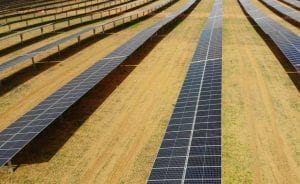The big question for some as they watched Qantas Airways’ first sustainable biofuels flight last week was this: Will the airline that likes to call Australia home be able one day to call the fuel it uses Australian?
The answer for the first flight was no – the fuel that made up one half of the 50/50 mix on one engine on a commercial flight from Sydney to Adelaide and back last Friday, and on a Jetstar flight from Melbourne to Hobart and back today – was derived from used cooking oil from the US; from a fast-food chain in Kansas, of all places.
And the chances are that even if Qantas does decide to embrace one or more biofuel feedstocks in coming years – be it cooking oil, algae fuel, urban and household waste or crop stubble – it will be several decades before it accounts for the majority of its fuel intake.
Qantas consumes nearly 5 billion litres of jet fuel a year (a bill of around $4 billion a year) and while its first biofuel flight means it is one of the first airlines to test out sustainable fuel alternatives, the reality is that its ambitions go no further than the industry average – which for the International Air Transport Association is to achieve carbon neutral growth by 2020 and reducing emissions by 2050.
Compared to what the science says about reduced emissions, and the ambitious targets set by the US Air Force and Navy, that may seem conservative. “This is not a quick or easy fix. We have got to start a whole new industry,” says John Valastro, the head of risk and resilience at Qantas. “We have got to jump a whole bunch of hurdles.”
As part of a project linked with its demonstration flights with fuel provided by SkyNRG, Qantas is doing a study with the Australian government and Shell to analyse what alternatives are available for the company in Australia. It is an extension to a detailed report conducted by the CSIRO last year that suggests Australia could source 5 per cent of its jet fuel requirements from bio-stock by 2020, rising to 40 per cent by 2050. That trajectory is considerably more ambitious than the IATA goals, and is predicted to deliver a 17 per cent cut in annual greenhouse emission per annum for business-as-usual by 2030, along with a $2 billion reduction in the annual bill for imported fuel, and the creation of 12,000 new jobs.
For that to happen, Qantas needs to establish that the feedstocks are scaleable and “rateable”, and that they will not compete with food or have an impact on biodiversity. Valastro says that for the moment, sustainable fuels are more expensive, but they will over time, and with scale, reduce their costs considerably. “We don’t see that (cost issue) as insurmountable. When you have scale and efficiencies, you will be able to drive that price down.”
Valastro says the airline is still considering joint ventures with Solena (waste to fuels) and Solazyme (sugar to energy), and is in discussions with other companies offering alternative solutions. He is fond of using the expression that there is “no silver bullet”, just a “silver shotgun” for sustainable solutions. Which effectively means that Qantas will likely source sustainable fuel from a variety of sources into the future. It’s a case of managing those inputs and costs.
Qantas will have no shortage of potential providers. One of those, Algae.Tec says algae fuels is a very real short-term prospect for aviation fuels. “This is a very welcome demonstration of the potential for biofuels to transform the way our transport industries use renewable and sustainable fuel,” Algae.Tec chairman Roger Stroud said of the demonstration flight.
Algae.Tec has already signed an agreement with Lufthansa to develop aviation fuels from algae, which can be harvested from feed-stocks such as carbon dioxide emissions, and has its first Australian project underway near Nowra in NSW, and has other ventures in Sri Lanka and China.
Valastro says the cooking oil from Kansas represented a 60 per cent reduction in emissions from jet fuel over the life cycle. Obviously, that reduction would be greater if the sustainable fuels could be sourced from Australia. “What we are saying is that this was a great start. Now we want to be specific, about the potential feedstocks, their reliability, their seasonality, and the refining capacity. We need to learn what each party within the value chain – feedstock providers, refiners, process, aggregators, and government – can offer.”







